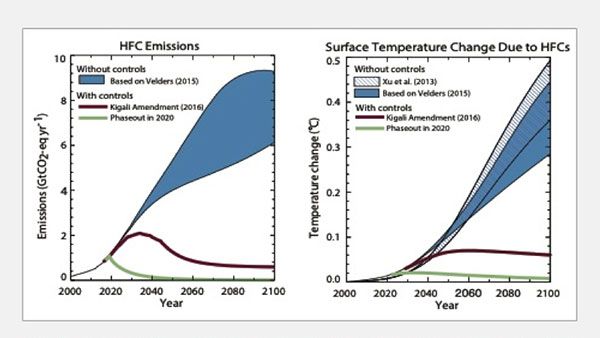Global agreement addressing ozone depletion will also bring large climate benefits
By Durwood J. Zaelke | January 2, 2019
 Global HFC scenarios without global controls and with full compliance with the Kigali Amendment. A scenario in which global HFC production phases out by 2020 also is shown. Credit: Scientific Assessment of Ozone Depletion:2018, Executive Summary.
Global HFC scenarios without global controls and with full compliance with the Kigali Amendment. A scenario in which global HFC production phases out by 2020 also is shown. Credit: Scientific Assessment of Ozone Depletion:2018, Executive Summary.
The Kigali Amendment to the Montreal Protocol entered into force this week, mandating the phase down of super climate pollutants called hydrofluorocarbons (HFCs). The amendment has now been ratified by 65 parties, including most recently Japan and Nigeria, surpassing the 20 ratifications needed to bring it into force. While US industry is supporting ratification, the Trump administration has not yet indicated whether it will send the amendment to the Senate for its advice and consent.
Two years ago, the parties to the Montreal Protocol agreed in Kigali, Rwanda to an amendment that will phase down the use of HFCs, potentially avoiding up to 0.5 degrees Celsius of average worldwide warming by 2100, if an expedited implementation strategy is followed. HFCs are often used in air conditioners and refrigerators as replacements for other substances that, when they break down, wind up depleting the stratospheric ozone layer that protects life on Earth from harmful radiation. HFCs don’t have that ozone-depleting effect, but do act as extremely potent greenhouse gases, exacerbating the climate change being created by emissions of carbon dioxide from the use of fossil fuels.
The initial phase-down schedule of the Kigali Amendment—under which HFC emissions would peak in 2040—will capture most of the 0.5 degrees C potential avoided warming, but not all, leaving up to 0.1 degrees C for future action. Assuming compliance, the amendment would avoid HFC emissions with the global warming equivalent of up 4.1 billion tons of carbon dioxide per year by 2050. That total of avoided emissions would rise to nearly 9 billion tons per year by 2100.
A “leapfrog” strategy that arrested global HFC production by 2020 would avoid the equivalent of an additional cumulative 53 billion tons of carbon dioxide from 2020 to 2060, according to the quadrennial Scientific Assessment of Ozone Depletion, prepared by the treaty’s Scientific Assessment Panel. The panel released its Executive Summary in November.
The scientific assessment notes that beyond phasing down HFC use, improving the energy efficiency of air conditioners and other cooling equipment has the potential to double the climate benefits of the Kigali Amendment. That’s to say, these combined strategies for dealing with HFCs could reduce projected warming by up to 1 degree by the end of the century. Such a reduction would temper some of the worst impacts of climate change now foreseen.
In a formal decision at their annual meeting in November, the parties to the Montreal Protocol noted that “improvements in the energy efficiency of refrigeration and air-conditioning equipment during the transition to low-global-warming-potential alternative refrigerants can potentially double the climate benefits of the Kigali Amendment” and authorized increasing funding for countries to implement energy efficiency. The decision directs the Multilateral Fund, the treaty’s dedicated financing mechanism, to explore cooperation and co-funding with other institutions, including the World Bank, which pledged $1 billion for the combined strategy in the runup to the Kigali Amendment.
The Scientific Assessment Panel reported that empirical evidence now shows that the treaty’s efforts to cut chlorofluorocarbons (CFCs) and other ozone-depleting substances was responsible for healing the stratospheric ozone layer, and that the Antarctic ozone hole should recover by the 2060s. The level of stratospheric ozone depleting substances in the atmosphere is continuing to decline, the panel reported, and total ozone levels in the Antarctic are showing signs of recovery.
As it is implemented and the parties gain confidence, the Kigali Amendment’s initial phase-down schedule will very likely be shortened for maximum climate protection. Such a move would be consistent with the history of the Montreal Protocol, which is often referred to as a “start-and-strengthen” treaty, because it has continuously strengthened its controls on ozone-depleting substances during 31 years of operation, after starting with what the current politics would allow, learning by doing, and gaining confidence to do still more.
Over the last three decades, this work-horse treaty has not only solved the first great threat to the global atmosphere—the destruction of the stratospheric ozone layer—but it has also solved an amount of the climate problem that would have equaled the contribution of carbon dioxide today. The Kigali Amendment and associated energy efficiency efforts are poised to add even more climate protection, providing hope that it is still possible to slow climate change in time to avoid the looming existential threat of uncontrollable climate change impacts.
Together, we make the world safer.
The Bulletin elevates expert voices above the noise. But as an independent nonprofit organization, our operations depend on the support of readers like you. Help us continue to deliver quality journalism that holds leaders accountable. Your support of our work at any level is important. In return, we promise our coverage will be understandable, influential, vigilant, solution-oriented, and fair-minded. Together we can make a difference.
Topics: Analysis, Climate Change















